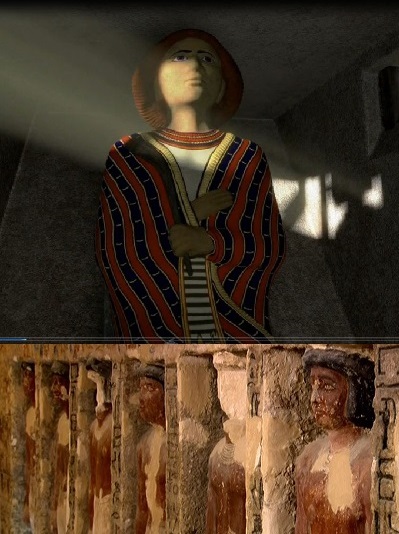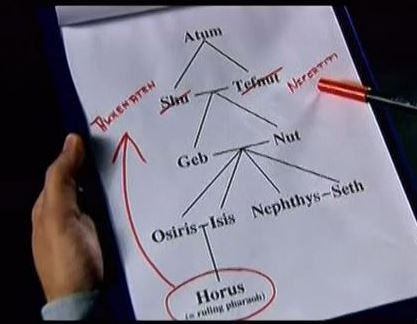|
|
|
Recently while at work I overheard a discussion among some of my co-workers. They were agreeing among themselves that the Biblical accounts of things like the creation of the universe and the major events of Christianity - like the birth of Jesus and his resurrection - were all just stories borrowed (or copied or plagiarized - whatever you want to call it) from the stories of the religions of other cultures.
I've heard that charge before, and as a Christian, I find the entire idea repugnant. It's not like they're talking about something inconsequential like a comic book or the like. After all, scripture reminds us the biblical accounts "are not just idle words for you--they are your life."(Dt 32.47) The fact that such discussions are still being entertained and the idea affirmed is proof that many people are still taking the bait and falling for the trap: being persuaded that this lie is true. Since people's eternities are a stake the only question is how best to respond?
Since the Proverbs warn us about butting in on discussions/arguments that are not our own (Prov 26.17), I didn't barge in right there, tempting as it was. But as it is a recurring question I consider it important that this lie from the pit be addressed - since it is obviously still out there misleading people. And since we are admonished to have nothing to do with godless myths (1 Tim 4.7) but rather expose them (Eph 5.11) - I wanted to provide a number of reasons why the claim that the biblical accounts (content, not format) are adapted from pagan sources is nothing but a pernicious lie. I particularly want those who want to examine the matter themselves (like the Bereans - Acts 17.11), to have the info needed to discover the truth.
Before moving on to the evidences of the main thrust of my argument, let me
start by commenting on the observations made by
others addressing this issue. Murray Adamthwaite makes a number of
helpful observations in his article
Is Genesis 1 Just Reworked Babylonian Myth? I've expanded on his
observations below.
In looking at the Enuma Elish[1], the so called "Babylonian
Creation Story", he observes that:
1. It is a political document, designed to show why
Babylon is the pre-eminent city. I would take that a step further and say
that almost all the pagan religions share a similar purpose: to show why
their God is the pre-eminent God. Which brings out another point:
Most pagan religions are polytheistic. They believe in many gods - a
pantheon of gods. This stands in stark contrast to the monotheistic
religion of the Bible.
Once you have a pantheon of gods, you must naturally explain why one god
is the supreme god over all the other gods. Thus the Babylonian epic
strives to show why the Babylonian god Marduk is the supreme God.
Egyptian stories strive to show why Amun-Ra is supreme. Norse stories
show why Odin is supreme. Greek stories show why Zeus is the supreme
God, etc. You get the point.
Again let me point out this is strikingly different from the biblical account: there is no competition among the gods because there is only one God. Thus unlike pagan stories, there is no need for the biblical God to conquer other gods to become supreme. He exists eternally as the unique supreme God. The God of the Bible declares over and over "I am God, and there is no other; I am God, and there is none like me." (Is 46.9) If the Israelites were copying, they did a poor job of it - missing the main point of many pagan stories.
2. The Enuma is theogony (story of the creation of gods) rather than cosmogony (story of the creation of the universe). Since many pagan myths are theogony you can see that the stories are patently false, being made and changed to suit the needs of the ruler or the priests at the time. Take for example the Egyptian pantheon. Dr. Christian Loeben of Humboldt University, Berlin[2] outlines the Egyptian family of gods as follows in the diagram:
You'll note in the above chart, the first 4 generations of Egyptian gods are shown. Atun is the supreme god, who creates the first divine couple Shu and his wife Tefnut, and on it goes down the line. The fourth generation is Horus who is equated with the ruling pharaoh of Egypt, and in this manner the pharaohs made their claim that they were gods, living on earth.
But this is obviously just a story because when Akhenaten, pharaoh of Egypt wants to eclipse his much beloved father, pharaoh Amenhotep III, builder of the vast and extravagant Karnak Temple complex which employed over 80,000 people[3], what can he do? There's peace in the land so no enemies to conquer to gain glory. He takes what he probably considers the only route possible for himself. He places himself higher in the hierarchy of gods than his father as shown in the following diagram:
So instead remaining in the place of the pharaohs at the level of Horus
and being considered a descendant of the lower gods Osiris and Isis, he claims to be the son of
the supreme god Atum, and he enthrones his wife Nefertiti beside him. Clearly no one is able to change the parents to
whom they are born, so he is obviously using the pagan Egyptian gods and
creation story to manipulate his circumstances to place himself in the
exalted position he feels he should occupy. Obviously he is not concerned with
the truth of his claims - because there is no truth to be found in any
of it. Were we to take the time, I'm sure we could likewise find many
other such patently false claims in the various other pagan religious stories.
3. "...In Enuma Elish the world and man are emanations from divine substance, i.e. both are of the “stuff” of gods."[4] Here, as well as in most pagan accounts, there is no concept of creation ex nihilo (from nothing), rather the world is fashioned out of something - typically the body of a god or a dragon.
Some would point to the use of pagan concepts like the dragon Rahab in Biblical accounts as evidence of borrowing. (For example Job 26.12) But as one commentator points out "The problem...is not one of borrowed theology but one of borrowed imagery."[5] We see the apostle Paul doing the same thing in Athens, employing the language and imagery of the local people to make a point - without adopting their pagan worldview. "'For in him we live and move and have our being.' As some of your own poets have said, 'We are his offspring.' (Acts 17.28) Paul uses this well known (to them) pagan quote as an entrée to the Christian gospel, having gotten their attention by using familiar language and concepts to his hearers.
4. Enuma Elish has no six-days-plus-one format.[6]
Thus neither the Babylonian, nor any other pagan mythology (and thus
also not the
"they copied" theory) can explain the origin of a day of rest
for a population of slaves. More
importantly, pagan mythology cannot explain why the Hebrews adopted the
Sabbath as a sign with a dual meaning: It is both a lasting sign of God
as creator; and
observance of the Sabbath is a lasting sign that the creator God is the
God of those who keep the Sabbath - namely the Hebrews as this scripture
shows:
The Israelites are to observe the Sabbath, celebrating it for the generations to come as a lasting covenant.
It will be a sign between me and the Israelites forever, for in six days the LORD made the heavens and the earth, and on the seventh day he abstained from work and rested.'"
Ex 31.16-17
The day of rest - the Sabbath - exists to this day as evidence of the uniqueness of the Biblical creation account. There is nothing like this in any pagan religion, so clearly this was not copied. Note also that at a key point in history: the Exodus - God ties the creation of the universe to the Exodus of the Hebrews - in the 4th commandment to remember the Sabbath (Ex 20:11) - given at the height of the exodus: the meeting of God at Mt. Sinai. So the Sabbath becomes as much as a reminder of the creation as it is of the Exodus. But if the Israelites just copied, neither the Sabbath, the Exodus nor their tie to creation should exist.
These evidences are just opening salvos. Before I get to the main volley, lets make sure we understand the underlying assumptions of the claim, because that will affect how we approach debunking the claim.
The claim is that the biblical accounts are based on pagan stories, by which they mean to say the biblical accounts are not accounts of history, but made up stories (like what Akhenaten did) and thus are not true. So the main thrust of the claim is that the biblical stories are not true. Pressing further we need to determine why it is claimed they are not true.
If the reason is simply because they are based on some other story, as apologist and writer Jonathan Sartfati points out in his article on this topic, that's an example of the genetic fallacy, and does not mean the accounts cannot be true. The genetic fallacy is the mistake of claiming something cannot be true because of its source. Consider this claim: Things learned in dreams cannot be true because they come from dreams. Yet dreams have revealed many truths. One example: Louis Agassiz, a 19th century naturalist, zoologist, geologist, and teacher, while working on "Poissons Fossiles" (Fish Fossils) a compendium of all known fish fossils, came across a specimen mostly encased in a stone slab. He was hesitant to remove stone, fearing he might damage the specimen in so doing because he couldn't be sure where the rock ended and the specimen began. Then he had a dream about the specimen - showing it's details. Actually he had 3 dreams, but as dreams are hard to remember once one awakes, he was not at first able to remember the details. On the third night, he left himself pencil and paper by his bed, and upon dreaming about it again, while half asleep, half awake sketched his dream. Using his drawing as a guide, he "...succeeded in chiselling away the surface of the stone under which portions of the fish proved to be hidden. When wholly exposed it corresponded with his dream and his drawing, and he succeeded in classifying it with ease"[7]
So even if based on a story, (and I'm not saying the biblical accounts are) that doesn't mean the story in question is not true. If the original story is true, there's a possibility the story about the story is also entirely true.
Which brings us to what I believe the real intended charge is when this claim is made. The intended claim is the pagan stories are not true, therefore the biblical accounts, which are based on the pagan stories are not true. This then is the claim that must be addressed, because if true that would threaten the veracity of the biblical accounts. How can we go about demonstrating such a claim is false? Very easily: provide documented evidence the biblical claims are true. Because if the biblical accounts were made up from a story that was not true, one would not expect to find evidence for either story.
For example, I could make the claim that the cartoon character "Mighty Mouse" is a fictional character because it is based on another character "Superman" that is also a fictional character. If my claim were true, then I would not expect to find any evidence of either Mighty Mouse or Superman. On the other hand if I were to find evidence of Mighty Mouse (his mouse sized tree house containing his mouse sized costume, along with testimonies from witnesses seeing a flying anthropomorphic mouse, etc.) - but not of Superman, that would indicate that the stories of Mighty Mouse were true, and came about independently of the stories of Superman - which would still be regarded as fiction.
So let's apply that logic to the Biblical accounts. If the stories in the bible are not true because they are based on pagan stories that are not true, we would not expect to find any evidence of either the biblical accounts or the pagan accounts. On the other hand if we were to find evidence of the Biblical accounts, but not of the pagan accounts, that would indicate that the Biblical stories are true, and are not based on pagan stories for which there is no evidence.
I've already provided one piece of evidence of the Biblical creation account: worship on the Sabbath which is a remembrance of both the creation, and the giving of the command to honor the Sabbath, which God gave before entering the promised land after the Exodus from Egypt. If the Biblical account is false - then none of the biblical stories should be true, neither the creation, nor the Exodus, nor the resurrection. No one can produce direct evidence of the creation (which is why the fairy tale of the Big Bang is still believed by some), but there are other accounts for which we have much evidence. And it's a key part of Biblical history and theology: the Exodus.
The Bible claims that the same God who created the heavens and earth also freed the Jewish nation (Ex 20.2, 11) from slavery to Egypt around 1446 BC, and delivered them to their own promised land - the land of Canaan. If the Biblical God is just a fiction like the pagan gods, he obviously cannot pull off the exodus. Non-existent beings cannot do such things. Thus if the God of the bible were mere fiction, we should find no evidence of the exodus. On the other hand, if we were to find evidence of the Exodus, that would prove both:
1. The account of the Exodus is true
2. The Biblical account is not based on pagan gods because as we noted
above, non-existent gods are incapable of doing anything.
Furthermore it would demonstrate the independence of the Biblical
accounts from pagan accounts, because there is nothing like the exodus
in pagan accounts.
While there are many persuasive evidences that the Exodus actually happened, for the purposes of this article we'll limit our examination to four of them.
Evidences of the Exodus
1. The Tomb of Joseph in Egypt
You can't have an exodus from Egypt unless you first arrive in Egypt.
The Bible records that Joseph was taken in slavery to Egypt (Gen 37.28), but rose to
become second only to Pharaoh in Egypt (Gen 41.44, Gen 45.9) and saved the Egyptians
(Gen 41.56-57) (and
Israelites - who subsequently moved to Egypt (Gen 45.9-11)) from a 7 year famine.
Joseph died in Egypt (Gen 50.26), but requested his
bones be taken to the promised land with his brothers when they departed
Egypt. (Ex 13.19)

Above is a recreation of a statue in the tomb. Egyptologist Charles
Aling[8] believes this is likely the tomb of
Joseph because:
- - Size - the cloaked statue is twice as large as a human, larger than what the average person would have had in their tomb; suitable for a very important person - like Joseph was
- - Hair style - not that of the Egyptians, more consistent with Hebrews
- - Weapon - Throw stick - used by Hebrews
- - Skin color - yellow, much lighter than how Egyptians depicted themselves (compare the lower picture of Egyptians - note the dark skin)
- - Coat of Many colors - associated with Joseph
- - Found in a complex with 12 pillars and 12 Graves (Joseph was of course one of 12 brothers, the sons of Jacob)
- -The tomb was empty (Thieves don't steal bodies; only people who care to tend to a body would remove it - as would a family to keep a promise)
Here we see the first step of the Exodus - proof that the Israelites migrated to Egypt, and that the account of Joseph rising to power is true.
2. The Ipuwer papyrus
- The Ipurwer papyrus is an Egyptian document written by a scribe known as Ipuwer. It is significant because it describes calamities that befell Egypt that match the Biblical plagues of the Exodus, and the chaos that followed.

Ipuwer Papyrus
From the water turning to blood (Ex 7.19) to the death of firstborn (Ex 12.12-13), Ipuwer describes many of the plagues in laments. For those looking for extra-biblical verification of the Exodus, here is one of them.
3. Grave Stele of Mycenae

Mycenae Grave stele (scene 3)
Tombstones today record in the local language bits of information -
the name of the person, dates of birth and death and perhaps a pithy
epitaph. In the Greek city of Mycenae 3500 years ago, the tomb stones
(individually known as a "stele") are adorned with pictures. In one
archeological site in Mycenae was found 3 steles of particular interest. As
journalist and filmmaker Simcha Jacobovici describes it: "...nobody
realizes that they have a 3500 year old movie if you will - 3 frames of
the parting of the sea."[9]
The first frame is the featured picture at the top of this article showing a man being chased by a man in a chariot with a spear or sword, while both are surrounded by water. In the second frame (not shown) the man, has reached higher ground and turns to face the man in the chariot. In the final frame (above), the warrior on the chariot has been thrown off the chariot and the horses look panicked and in disarray as the waves appear to be bigger and closing in, while the man on high ground watches on. Ask yourself - what could throw a man on a chariot (the 15th century BC equivalent of a tank) off of it? Certainly the man he's chasing has no power to do that. When you consider them together, the three steles appear to be a visual depiction of the biblical account of the army of Pharaoh chasing the Israelites into waters the Lord had parted, (Ex 14.21-30) ending with the horse and rider thrown into the sea as Miriam, the sister of Moses sang. (Ex 15.21)
So here we have a 3500 year old depiction of the biblical account of the Exodus. Further confirmation that the Exodus actually happened.
4. Coral in the shape of Chariot Wheels
The Bible records that Pharaoh sent 600 of his best Chariots along with
other men and chariots and pursued the Israelites as they were departing
Egypt. (Ex 14.7) If that is the case, and the Egyptian army perished in
the sea when God brought the waters crashing down upon them (Ex 14.28), then there should be evidence of the Egyptian army at the bottom
of the sea. And as it turns out there is: clear evidence of Egyptian
chariots submerged has been found where it is expected the Israelites crossed through
the waters parted by God.
_312.jpg)
Coral is a living organism that attaches to an
object before growing. After attaching, it will sometimes take on the
shape of the object. Dr. Lennart Möller of the
Karolinska Institute, Stockholm, Sweden was part of an expedition that
went in search of evidence for the Exodus. He describes the above coral
(which doesn't normally grow with right angles) as follows: "It's a 90
degree angle, a right angle between something
that looks like an axle and the wheel. And you can see this in different
varieties. And it looks very different from normal coral growth. And it
is like a man-made structure with a coral growth on it."[10]
In other words it looks like the wheels of a chariot, with the axle still attached, lying on its side, with coral having attached to it and grown on it. But even better than that is a picture that was taken of a wheel that conforms to the style and dimension of a four spoke Egyptian Chariot wheel that was "...painted on an 18th dynasty tomb wall near the biblical date of the exodus."[11] (below)

What are Egyptian chariot wheels and axles doing at the bottom of the sea where the Israelites crossed if the Exodus never happened?
Conclusion
This is just some of the evidence that can be adduced in support of the
Biblical Exodus, and thus in support of the Biblical accounts, including
the God of the Bible and the biblical creation account. And recall
- if this is all false because it's borrowed there should be no evidence
of any biblical event, just like you won't find any evidence for "Mighty
Mouse" save the cartoon stories made about him.
So anyone telling you that "the biblical accounts
were just copied from pagan religions" has probably never read the pagan
accounts - otherwise they'd realize how different they are; nor have
they bothered to investigate what evidence has been discovered in
support of the biblical accounts.
Next up - we'll look at another common but false accusation: that the
account of Jesus rising from the dead is likewise borrowed from pagan
myths. That will be covered in part 2 of this article.
Duane Caldwell | posted 11/29/2016
Follow @duanecaldwell
Notes
1. An outline of the Enuma Elish is given in
Adamthwaite's article:
Murray Adamthwaite, Is Genesis 1 Just Reworked Babylonian Myth?,
Creation Ministries International (CMI),
http://creation.com/is-genesis-1-just-reworked-babylonian-myth, 4
June, 2013
Back
2. Christian Loeben, ref
from Akhenaten and Nefertiti - The Royal Gods of Egypt,
Documentary, 2013
Back
3. The importance
of Karnak at it's height cannot be over stated. In addition to employing
80,000 people, it controlled 400,000 animals and a 1/2 million acres of
land. Like the Vatican, it was "a state within a state, a world within a
world." All dedicated to king of the Egyptian pantheon Amun-Ra.
Planet Egypt - "Temples of Power", Documentary, 2011
Back
4. Adamthwaite,
Is Genesis 1 Just Reworked Babylonian Myth
Back
5. Ronald Barclay Allen,
"The Leviathan-Rahab-Dragon Motif in the Old Testament (Unpublished
Master's thesis, Dallas Theological Seminary, 1968.)
ref from Bruce K. Waltke, Creation and Chaos, Portland Oregon:
Western Conservative Baptist Seminary, 1974, pp.13-14
Back
6. Adamthwaite, Is
Genesis 1 Just Reworked Babylonian Myth
Back
7. Agassiz's Fish,
World Dream Bank,
http://www.worlddreambank.org/A/AGASFISH.HTM accessed 11/25/2016
Back
8.
Charles Aling ref
from Patterns of Evidence: Exodus, Documentary by Timothy P.
Mahoney, 2014
Back
9 Simcha Jacobovici,
The Exodus Decoded, Documentary,
2006
Back
10. Lennart Möller, ref
from The Exodus Revealed, Documentary, Discovery Media
Productions, 2001
Back
11. Narrator,
The Exodus Revealed
Back
Images:
Featured Image: Mycenae Grave stele (frame 1) |
CCA
Egyptian deity chart1: Akhenaten and Nefertiti - The Royal Gods of
Egypt
Egyptian deity chart2: Akhenaten and Nefertiti - The Royal Gods of
Egypt
Statue of Joseph: Patterns of Evidence
Painted Egyptian reliefs: The Lost Gods: The Egyptians
Ipuwer papyrus (public domain)
Mycenae Grave stele (frame 3): The Exodus Decoded
Coral growth with superimposed chariot wheel: The Exodus Revealed
Submerged Egyptian chariot wheel: The Exodus Revealed


